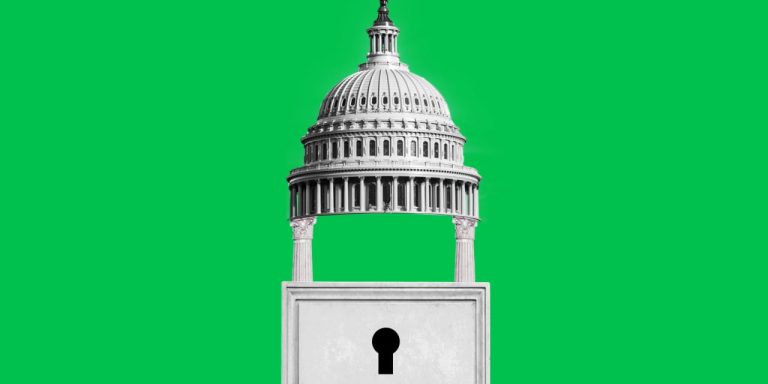President Biden signed late Saturday evening a stopgap bill funding the government through mid-November after it passed in the House of Representatives and the Senate, averting a shutdown.
“Tonight, Congress voted to keep the government open, preventing an unnecessary crisis that would have inflicted needless pain on millions of hardworking Americans,” Biden said in a post on X. “This is good news, but I want to be clear: we should never have been in this position in the first place.”
The move allows lawmakers more time to reach a deal on government spending in the next fiscal year.
Earlier today, a handful of Republicans joined nearly all the Democrats in the U.S. House of Representatives to pass the stopgap measure proposed by House Speaker Kevin McCarthy (R., Calif.).
While a shutdown is temporarily out of the picture, the path ahead remains long and uncertain.
Congress needs to pass 12 appropriations bills—each funding different functions of the federal government—before the continuing resolution’s term runs out on November 17. But if the past few weeks are any indication, Democrats and Republicans will have a tough time hammering out the details.
In the lead-up to Saturday’s stopgap bill, hard-right conservatives in the House of Representatives have demanded budget cuts that are too steep for more moderate members of the chamber, and insisted on eliminating programs and policies considered “woke” such as reimbursement for military members who have to travel for an abortion. Democrats, meanwhile, have been asking for more funding for the war in Ukraine and natural disaster relief, which some Republicans have fiercely opposed.
The measure that passed Saturday sustained most spending at current levels, though it lacked funding to aid Ukraine in its war with Russia.
This past week, the Republican-led House of Representatives voted to pass three long-term spending bills, including one that would fund the nation’s defense efforts, to satisfy the hardliners’ demand. However, the chamber failed to pass an agriculture bill which contained anti-abortion provisions and sparked concerns from some representatives. The Senate has passed none.
The U.S. government has seen three shutdowns in the past 10 years. The last one lasted more than a month—the longest in U.S. history—in 2018 during President Donald Trump’s administration, when Democrats refused to fund the U.S.-Mexico border wall that Trump demanded. It ended with a concession from Trump and Republican lawmakers.
Had a shutdown taken place this time, hundreds of federal agencies and programs would have run out of money on Sunday, although many have capital reserves from previous years or alternative sources of income to sustain themselves for days or weeks without new federal budgets.
Given the frequency of government shutdowns in recent years, investors have largely shrugged them off as nonevents. Traditionally, there has been a mild drag on economic growth for the duration of a shutdown, with growth rebounding by a commensurate amount once Congress passes spending legislation and the government reopens.
The outlook wasn’t so benign this time around.
Until Saturday afternoon, lawmakers in Washington appeared locked in a bitter standoff over spending legislation, leaving the government all but certain to shut down just after midnight on Sunday, Oct. 1. If that happened, an estimated 800,000 workers would have been furloughed, while hundreds of thousands of others would have been working without pay. The vast network of government subcontractors would also have been out of work, and unlike their federal counterparts, they wouldn’t have received back pay.
Those lost hours of work, and the resulting hit to consumer spending, were estimated to cost the U.S. economy $6 billion a week, according to calculations by Gregory Daco, chief economist at EY-Parthenon. That would have meant shaving 0.1% off real gross domestic product in the fourth quarter for each week that the shutdown lasted.
Republicans had joined with Democrats Friday night to defeat a stopgap measure proposed by McCarthy that would have slashed spending and imposed harsh new immigration controls.
Libby Cantrill, head of U.S. policy at Pimco, described the politics at play as a “Sophie’s choice” for McCarthy. His options appeared to be either to work on bills that would appease a small cadre of far-right lawmakers but had no shot at passing the Democratic-led Senate, or work across the aisle to keep the government open but likely risk his speakership.
He appears to have opted for the latter.
The challenge, Cantrill said, is that those political dynamics wouldn’t have changed even after the funding deadline passed, which is why she was worried the conflict could have become protracted. “Our concern is that the reasons why the government would shut down are, in some ways, the reasons why it may not reopen quickly,” Cantrill told Barron’s before Saturday’s House vote.
The economic impact of a brief shutdown would have been “very negligible,” Daco said before the vote. But the costs would have piled up until a deal was struck. While economic and political analysts had expected a shutdown to last for at least two or three weeks, there was growing concern that disagreements in Congress are so entrenched that it could have stretched on far longer than that—perhaps more on par with the 2018-19 partial shutdown that lasted 35 days, the longest in U.S. history.
This spending fight could have lasted longer than others for two reasons. For one, there was nothing on the political calendar that would have forced the two sides together by a particular time, especially because missing the deadline to pass the spending legislation in the first place would have had only mild consequences.
That was in contrast to recent fights over the debt ceiling, the breaching of which would have carried crippling economic and financial ramifications.
The previous full government shutdown, in 2013, was tied to a debt-ceiling fight, and lawmakers ultimately compromised and passed the necessary appropriations bills just before reaching the so-called X-date, which would have forced the country to default.
The impasse, with all of its accumulating costs, would have hit the U.S. economy alongside a handful of other headwinds. Oil prices, for one, are rising, pushing headline inflation up and cutting into consumer spending. Student-loan payments are on track to restart after more than three years of forbearance programs. The last of the Covid-era stimulus money that has helped keep the child-care industry afloat is about to run out. And tens of thousands of autoworkers are on strike as employees push for higher wages.
Plus, for as long as the government is shut, the Federal Reserve wouldn’t receive most of the economic data it uses to craft monetary policy, including updated figures on jobs, inflation, and economic growth. That could have made it harder to see how the economy is reacting to various external factors, such as higher interest rates, and raise the odds of a policy misstep.
All that added up to it looking like “a tough quarter,” Mark Zandi, chief economist at Moody’s Analytics, said before the House vote.
Write to Jacob Adelman at [email protected] and Megan Cassella at [email protected]
Read the full article here









